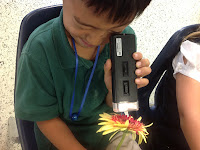As part of our
nutrition study, we set up 3 centers today for taste-tests. Palatable great nutrition is our goal! This is what we did:
Natural Sweeteners
Honey, Agave, and Maple Syrup: From
insects, plants and trees. We discussed
which one was the sweetest and most pleasant. Thank
you God, for taste buds!
Quinoa, Red Beans and
Seasoned Ground Chicken
Our version of the Bayou classic substitutes ground chicken for sausage, and
quinoa, a high-protein grain from South America, for the rice. Talk about your protein! Mrs. Funderburg makes quinoa in apple juice
for breakfast cereal for her boys.
Hummus
Ground garbanzo beans, sesame tahini and lots of garlic make for a fantastic
spread on pita bread.
Serenity shared her family’s hummus recipe:
Drain and rinse two cans garbanzo beans (preferably Bush's).
Dump in the Cuisinart.
Add heaping teaspoon of fresh garlic.
Add sea salt for taste.
Add one squeezed lime.
Add about 1/2 a cup of plain Greek yogurt
(regular plain yogurt will work)
Pulverize until a nice, smooth paste.
Add garlic powder, onion powder, salt and pepper for taste!
 |
| Mrs. Funderburg guides Sam through blog posting. |
David is a Redeemer student who is from Korea. He is tasting quinoa. He says it tastes fabulous.






















